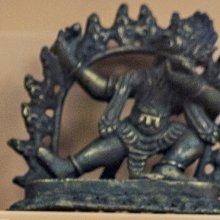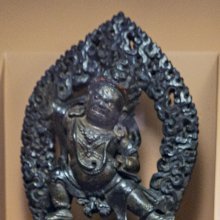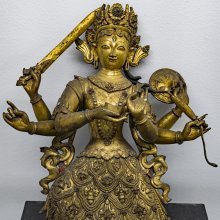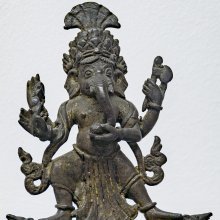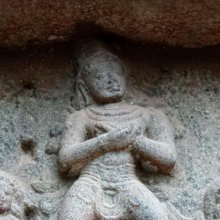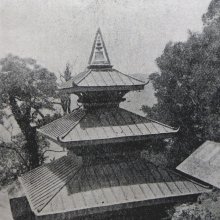Alidha, Ālīḍha, Ālīḍhā: 18 definitions
Introduction:
Alidha means something in Hinduism, Sanskrit, Jainism, Prakrit. If you want to know the exact meaning, history, etymology or English translation of this term then check out the descriptions on this page. Add your comment or reference to a book if you want to contribute to this summary article.
Images (photo gallery)
(+17 more images available)
In Hinduism
Natyashastra (theatrics and dramaturgy)
Source: Wisdom Library: Nāṭya-śāstra1) Ālīḍha (आलीढ).—One of the 32 aṅgahāras (major dance movement) mentioned in the Nāṭyaśāstra chapter 4. It is also known by the name Udhṛttaka. The instructions for this ālīḍha-aṅgahāra is as follows, “assuming Vyaṃsita-karaṇa, striking the hands on the shoulder, and then Nūpura K, with the left foot [moving first], afterwards Alāta and Ākṣiptaka Karaṇas with the right foot [moving first] and then making Uromaṇḍala gestures with hands and assuming Karihasta and Kaṭicchinna Karaṇas.”.
2) Ālīḍha (आलीढ) also refers to a type of Sthāna (standing posture) defined in the Nāṭyaśāstra chapter 11.
(Instructions for Ālīḍha): The right foot in the maṇḍala-sthāna drawn five tālas apart from the other foot will make the ālīḍha-sthāna, Rudra (Śiva) is its presiding deity.
(Uses of Ālīḍha): This sthāna should be assumed in all acts relating to the Heroic and the Furious Sentiments, duel of wrestlers and in the representation of enemies, an attack on them, and release of missiles.
Source: Shodhganga: The significance of the mūla-beras (natya)Ālīḍha (आलीढ) refers to one of the nine maṇḍala (postures of the feet) which represents one of the four “movements of the feet” (pāda) according to the Abhinayadarpaṇa. The third maṇḍala is the ālīḍha where the left foot is placed at a distance of three vitastis away in front of the right foot. With this term there is a posture in iconography where the standing figure has the bent left leg placed in front with the right leg stretched out behind.
Source: Shodhganga: Elements of Art and Architecture in the Trtiyakhanda of the Visnudharmottarapurana (natya)Āliḍha (आलिढ) refers to “one of the six kinds of standing postures for Men” (in Indian Dramas), according to the Viṣṇudharmottarapurāṇa, an ancient Sanskrit text which (being encyclopedic in nature) deals with a variety of cultural topics such as arts, architecture, music, grammar and astronomy.—Standing postures are determined separately for male and female. In the Viṣṇudharmottarapurāṇa six kinds of standing postures are discussed for men. According to the Viṣṇudharmottarapurāṇa, the maṇḍala posture becomes āliḍha when the distance between two legs is five tālas. The Śabdakalpadruma states that in āliḍha posture the right leg should be extended and the left leg should be contracted. This position is used to denote furious things as well as taken at the time of fighting. Due to the edition of the prefix called prati which means opposite, pratyāliḍha posture denotes that posture which is totally the opposite of āliḍha posture.

Natyashastra (नाट्यशास्त्र, nāṭyaśāstra) refers to both the ancient Indian tradition (shastra) of performing arts, (natya—theatrics, drama, dance, music), as well as the name of a Sanskrit work dealing with these subjects. It also teaches the rules for composing Dramatic plays (nataka), construction and performance of Theater, and Poetic works (kavya).
Shilpashastra (iconography)
Source: Shodhganga: The significance of the mūla-beras (śilpa)Ālīḍha (आलीढ) or Ālīḍhāsana similar to the ālīḍha-maṇḍala in Bharatanatyam, as defined according to texts dealing with śilpa (arts and crafs), known as śilpaśāstras.—There is a posture in iconography where the standing figure has the bent left leg placed in front with the right leg stretched out behind. The legs are held one behind the other and the arms represent the stretched string of a bow. The left hand holds a bow in a śikhara-mudrā, and the right hand is in kaṭaka-mudrā, with the string and arrow pulled back. This posture is not exactly the same as it is used in the practising trend of dancing with dancers following the Abhinayadarpaṇa text for the technicalities, but is similar to the descriptions given in Nāṭyaśāstra. The sūrasaṃhāra-mūrti of Murukan fighting with the Asūras is found in the ālīḍha posture. This image is found in the Subrahmaṇ ya Temple in Tirucchentur. The image of Manmadan (God of love) is found in this posture. Manmadan in this posture is found in the Rāmasvāmi Temple in Kumbhakonam and also in the Kamphakareśvar Temple in Tirubhuvanam.

Shilpashastra (शिल्पशास्त्र, śilpaśāstra) represents the ancient Indian science (shastra) of creative arts (shilpa) such as sculpture, iconography and painting. Closely related to Vastushastra (architecture), they often share the same literature.
Purana and Itihasa (epic history)
Source: archive.org: Shiva Purana - English TranslationĀlīḍha (आलीढ) or Ālīḍhasthāna refers to the “posture for shooting” (the right knee advanced and the left leg retracted), according to the Śivapurāṇa 2.2.3.—“[...] After thinking like this and deciding on his further activity, Kāma fitted his flower-arrows. Kāma, the foremost of archers, stood steady in the posture (sthāna) of Ālīḍha, bent his bow almost into a circle and was ready to shoot. O excellent sage, when the bow was kept ready by him, fragrant winds delighting everyone blew there. The enchanter then charmed Brahmā and others, the mental sons with several sharp flower-arrows”.

The Purana (पुराण, purāṇas) refers to Sanskrit literature preserving ancient India’s vast cultural history, including historical legends, religious ceremonies, various arts and sciences. The eighteen mahapuranas total over 400,000 shlokas (metrical couplets) and date to at least several centuries BCE.
General definition (in Hinduism)
Source: Wisdom Library: Hinduism1) Ālīḍha (आलीढ) is a Sanskrit word translating to “licked up”, “eaten”, “scraped” or “polished”. It can also refer to “a particular attitude in shooting” (the right knee advanced, the left leg drawn back).
2) Ālīḍhā (आलीढा) is a Sanskrit word referring to “A woman in menstruation”.
In Jainism
General definition (in Jainism)
Source: The University of Sydney: A study of the Twelve ReflectionsĀlīḍha (आलीढ) or Samālīḍha refers to “being (completely) consumed” (by the fire of meditation), according to the 11th century Jñānārṇava, a treatise on Jain Yoga in roughly 2200 Sanskrit verses composed by Śubhacandra.—Accordingly, “A corporeal [soul] becomes pure like gold immediately karma, whose existence is without a beginning and which is completely consumed by the fire of meditation (dhyānānala-samālīḍha), is destroyed”.
Synonyms: Pūrṇa, Ākīrṇa, Avakīrṇa, Vyāpta, Samākīrṇa, Samālīḍha, Saṃbhṛta.

Jainism is an Indian religion of Dharma whose doctrine revolves around harmlessness (ahimsa) towards every living being. The two major branches (Digambara and Svetambara) of Jainism stimulate self-control (or, shramana, ‘self-reliance’) and spiritual development through a path of peace for the soul to progess to the ultimate goal.
Languages of India and abroad
Sanskrit dictionary
Source: DDSA: The practical Sanskrit-English dictionaryĀlīḍha (आलीढ).—p. p. [ā-lih-kta]
1) Licked, eaten, lapped, scraped.
2) Wounded, hurt; सेनान्यमालीढमिवासुरास्त्रैः (senānyamālīḍhamivāsurāstraiḥ) R.2.37.
3) Closed (as in sleep) Daśakumāracarita 117.
-ḍham A particular attitude in shooting, the right knee being advanced and the left leg retracted; अतिष्ठदालीढविशेष- शोभिना (atiṣṭhadālīḍhaviśeṣa- śobhinā) R.3.52; see Malli. on Kumārasambhava 3.7.
--- OR ---
Ālīḍhā (आलीढा).—A woman in menstruation; नालीढ्या परिहतं भक्षयीत कदाचन (nālīḍhyā parihataṃ bhakṣayīta kadācana) Mahābhārata (Bombay) 18.14.9.
Source: Cologne Digital Sanskrit Dictionaries: Edgerton Buddhist Hybrid Sanskrit DictionaryĀlīḍha (आलीढ).—ppp. of ā-lih, in an-ālīḍha Laṅkāvatāra-sūtra 14.13; 172.12 (Suzuki not tasted, probably rather) not ‘licked’ = not grazed, not (even) lightly touched (by sectarian or heretical theo- rists); applied to questions or doctrines to be expounded.
Source: Cologne Digital Sanskrit Dictionaries: Shabda-Sagara Sanskrit-English DictionaryĀlīḍha (आलीढ).—mfn.
(-ḍhaḥ-ḍhā-ḍhaṃ) 1. Eaten. 2. Licked. n.
(-ḍhaṃ) An attitude in shooting, the right knee advanced, the left leg retracted. E. āṅa before lih to lick, kta aff.
Source: Cologne Digital Sanskrit Dictionaries: Cappeller Sanskrit-English DictionaryĀlīḍha (आलीढ).—[neuter] licked, touched, smoothed, polished; [neuter] a cert. attitude in shooting.
Source: Cologne Digital Sanskrit Dictionaries: Monier-Williams Sanskrit-English Dictionary1) Ālīḍha (आलीढ):—[=ā-līḍha] [from ā-lih] mfn. licked, lapped by the tongue
2) [v.s. ...] licked up, eaten, [Rāmāyaṇa; Mahābhārata; Raghuvaṃśa]
3) [v.s. ...] scraped, polished
4) [v.s. ...] m. Name of a man, ([gana] śubhrādi, [Pāṇini 4-1, 123])
5) [v.s. ...] n. a particular attitude in shooting (the right knee advanced, the left leg drawn back) [commentator or commentary] on [Kumāra-sambhava; Raghuvaṃśa]
Source: Cologne Digital Sanskrit Dictionaries: Yates Sanskrit-English DictionaryĀlīḍha (आलीढ):—[ā-līḍha] (ḍhaṃ) 1. n. An attitude in shooting. p. Licked, eaten.
Source: DDSA: Paia-sadda-mahannavo; a comprehensive Prakrit Hindi dictionary (S)Ālīḍha (आलीढ) in the Sanskrit language is related to the Prakrit words: Āliddha, Ālīḍha.
[Sanskrit to German]
Sanskrit, also spelled संस्कृतम् (saṃskṛtam), is an ancient language of India commonly seen as the grandmother of the Indo-European language family (even English!). Closely allied with Prakrit and Pali, Sanskrit is more exhaustive in both grammar and terms and has the most extensive collection of literature in the world, greatly surpassing its sister-languages Greek and Latin.
Prakrit-English dictionary
Source: DDSA: Paia-sadda-mahannavo; a comprehensive Prakrit Hindi dictionary1) Ālīḍha (आलीढ) in the Prakrit language is related to the Sanskrit word: Ālīḍha.
2) Ālīḍha (आलीढ) also relates to the Sanskrit word: Ālīḍha.
Prakrit is an ancient language closely associated with both Pali and Sanskrit. Jain literature is often composed in this language or sub-dialects, such as the Agamas and their commentaries which are written in Ardhamagadhi and Maharashtri Prakrit. The earliest extant texts can be dated to as early as the 4th century BCE although core portions might be older.
Kannada-English dictionary
Source: Alar: Kannada-English corpusĀlīḍha (ಆಲೀಢ):—
1) [adjective] tasted; bitten; eaten.
2) [adjective] covered; spread all over; diffused through the whole of.
--- OR ---
Ālīḍha (ಆಲೀಢ):—
1) [noun] a particular stance in fighting or shooting, the right knee being advanced and the left leg retracted.
2) [noun] (dance) one of the thirty two ಅಂಗಹಾರಗಳು [amgaharagalu] (artistic combination of ಕರಣಗಳು [karanagalu]) involving both the feet.
Kannada is a Dravidian language (as opposed to the Indo-European language family) mainly spoken in the southwestern region of India.
See also (Relevant definitions)
Starts with: Alidhaka, Alidhapada, Alidhasana, Alidhasthana.
Ends with (+1): Abalidha, Analalidha, Analasamalidha, Analidha, Anupalidha, Ardhavalidha, Avalidha, Dhyanalidha, Dhyanasamalidha, Duhkhalidha, Kubjalidha, Kumaralidha, Latalidha, Paccalidha, Pajjalidha, Palita, Phalidha, Praryavalidha, Pratyalidha, Samalidha.
Full-text (+67): Pratyalidha, Alidheya, Aliddha, Pratyalidhasana, Analidha, Alih, Alidhasana, Alitam, Salih, Vajrayogini, Alidhasthana, Alidhapada, Ubhayavarahananamarici, Garuda, Vyamsita, Aryavajravarahi, Purna, Akirna, Vajrasattva, Padmanarteshvara.
Relevant text
Search found 18 books and stories containing Alidha, Ālīḍha, Ālīḍhā, A-lidha, Ā-līḍha; (plurals include: Alidhas, Ālīḍhas, Ālīḍhās, lidhas, līḍhas). You can also click to the full overview containing English textual excerpts. Below are direct links for the most relevant articles:
Gati in Theory and Practice (by Dr. Sujatha Mohan)
Gati in vehicles < [Chapter 3 - Application of gati in Dṛśya-kāvyas]
Relevant Sthānas and Nyāyas related to perform the Gati < [Chapter 2 - Concept and technique of Gati]
Gait identified in the martial arts of India < [Chapter 4 - Practice of Gati]
Amarakoshodghatana of Kshirasvamin (study) (by A. Yamuna Devi)
Education (10): Knowledge in Archery < [Chapter 4 - Cultural Aspects]
The Indian Buddhist Iconography (by Benoytosh Bhattachacharyya)
Figure 191 - Emanations of Ratnasambhava: Vajrayoginī
Figure 152-155 - Emanations of Vairocana: Aṣṭabhuja and Daśabhujasita Mārīcī
Sahitya-kaumudi by Baladeva Vidyabhushana (by Gaurapada Dāsa)
Text 10.240 < [Chapter 10 - Ornaments of Meaning]
Vishnudharmottara Purana (Art and Architecture) (by Bhagyashree Sarma)
2.3. Standing Postures < [Chapter 3 - Drama and Dance]
Varahi Tantra (English Study) (by Roberta Pamio)
Chapter 29 - The worship of Caṇḍikā < [Summary of the Vārāhī Tantra]
Chapter 12 - The Dhyānas (supports for the meditation) of the Goddess < [Summary of the Vārāhī Tantra]
